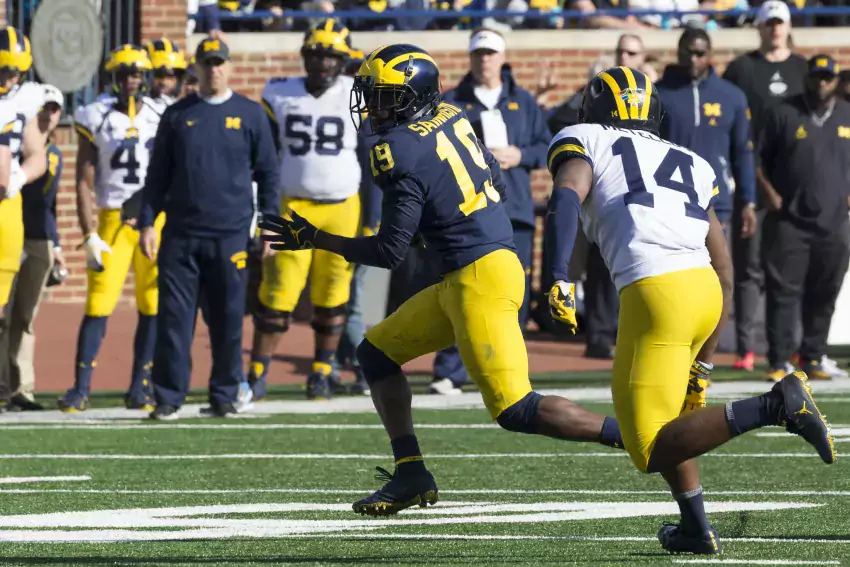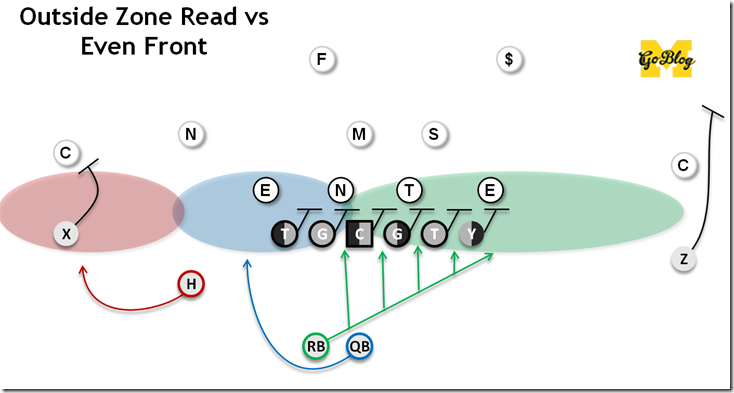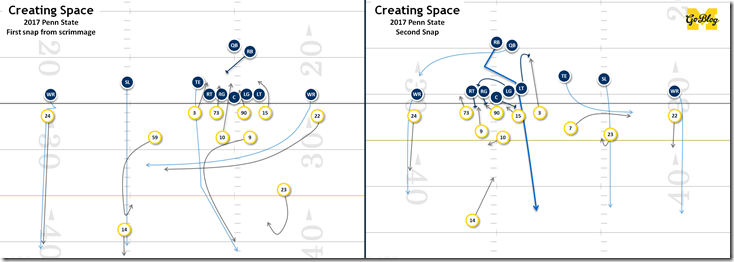vertical attacking from slot

So you know Josh Gattis has a philosophy. Michigan's new offensive coordinator, a former safety with a short trip in the NFL, spent the bulk of his coaching career as part of the brain trust propping up James Franklin. Two of those seasons came under Joe Moorhead, now head coach of Mississippi State, and one of the premier offensive minds in the game.
Now, the concept of speed in space is just barely more modern than toughness. What we're really talking about when we say "philosophy" is a slider: how much do your play designs emphasize that one aspect, and how. In historical Franklin spreads—and Rich Rodriguez offenses I should add—the stress put on the defense is extremely horizontal.
Verticality was an important changeup of course but note that resources in his base play are all about generating horizontal spacing: the defensive front has to control outside gaps that are widening every second, with the QB run and a pre-snap bubble read to force defenses to keep their material to the backside.
Moorhead's philosophy, however, is extremely vertical. Take the first two plays he ran against us in 2017:
These plays also threaten horizontally—that second play is an Inverted Veer, the modern cousin of the standard "get to the edge or cut behind overpursuit" play of the 20th century. He's flipped the QB and RB for some extra flavor but the base concept is to drag three defenders far away from the play on the wide side and threaten to run outside the other way, pulling a backside guard and optioning the last guy on the line of scrimmage to get numbers over there.
But note how he uses the receivers here. In both instances Moorhead is using three of his eligible receivers to go long, and running a fourth underneath. It's a big material commitment, but a hallmark of his offenses. And they're not just for show; Moorhead's offenses almost always feature one or two receivers with double-digit TDs and 17 yards per catch on 55% catch rates to back up his Dr. Strangelove reputation.
Other hallmarks of Moorhead designs are he likes to get underneath defensive players moving laterally before and after the snap, and he likes to use creative options and things that look like options to freeze edge defenders. Coach Matt Wyatt of RenasantNation.com had a great video last year on Moorhead's offense and the creative ways they got the ball to Saquon Barkley, but see if you can see these concepts at play:
Warning: Our 2017 Penn State game features after some OSU & MSU
Given Josh Gattis really comes from the Franklin tree, I was very interested in the Spring Game to see how much of Moorhead he'd adopted. The answer: I think most of it.
[After THE JUMP: Al Borges?!?]

[Bryan Fuller]
Previously: Podcast 10.0A. Podcast 10.0B. Podcast 10.0C. The Story. Quarterback. Running Back. Wide Receiver. Tight End And Friends. Offensive Tackle. Interior Offensive Line. Defensive Tackle. Defensive End. Linebacker. Cornerback. Safety. Special Teams. Questions: Offense.
1. Uh, So... Hey
That's not a question.
Do I even have any questions?
That's a question.
What are you, the Question Identifier?
That's also a question.
I guess what I'm saying, Question Identifier, is that even the bolded alter-ego is pretty dang sanguine about this.
But many things could go wrong!
Like what?
Several people in a line for tacos could all get injured at the same time when a dog made of metal runs through their achilles tendons.
That seems a little tenuous.
FINE. Look, just come up with something.
[After THE JUMP: something is come'd up with]
Scott Matzka has a very bad disease. Former Michigan hockey player Scott Matzka, who was a short-handed goal waiting to happen and took EECS 380 at the same time I did, has ALS. Please visit his site and help out if you can.
A Michigan Man does not jackknife powerbomb Kevin Nash.
Saw @RealKevinNash at the airport today. Almost jackknife powerbombed him through tarmac. Opted for picture instead pic.twitter.com/OXD8lCPZH7
— Henry Poggi (@The_Hank_Poggi) July 1, 2016
Apparent attrition. Brad Hawkins has not enrolled:
Hawkins' high school coach at Camden, Dwayne Savage, confirmed that Hawkins is not in school yet as he's still awaiting clearance from the NCAA Clearinghouse -- now known as the NCAA Eligibility Center. Savage said that Hawkins still plans on playing football at Michigan this season and hopes to have his clearance at some point toward the middle of July.
"He's not in school yet," Savage said. "I believe it's a Clearinghouse situation. Right now everything's still a go for Michigan. He just has to get everything cleared before he can step on campus."
This doesn't happen often with Michigan recruits so I don't have a feel for how likely it is that things get resolved by fall. Sam Webb is saying he doesn't have high hopes Hawkins will enroll this fall. Michigan might pick him back up after a prep semester.
If you've read the recent recruiting profiles, you know that in my opinion this is more of an issue for the safety depth chart than receiver because I really like the two sleeper-ish guys they took and have yet to get to Dylan Crawford.
Speaking of those sleeper-ish guys. PSU, OSU, and MSU are all using a ton of cover four, so this Ian Boyd article on the route slot receivers have to get down to bust these Ds is of considerable relevance:
For teams with QBs that have enough arm, against cover 4 defenses that like to bracket the single side receiver, this is a really popular way to attack the field safety:
Defenses that either want to bracket the single-side receiver in cover 2 or else drop the boundary safety down to stuff the run love to play this coverage against trips formations. The outside corner is in straight man coverage on the "X" receiver while the space-backer (S), middle linebacker (M), and field safety (F) are playing zone over the two slot receivers.
This is variously called "flag" or "seven" or a "corner" route. I go with the latter in UFR, FWIW.
Impact on the game
Perhaps the biggest response to cover 4 that has come into vogue around the game is the use of vertical routes from the slot receiver with which to attack the safeties. There are other good route combinations for attacking cover 4 that don't include seven routes but they all generally involve sending a slot receiver down the field to either attack the safety or occupy him so the offense can isolate a corner.
Teams that don't have receivers they can use in the slot to attack safeties down the field are at a major disadvantage in stopping cover 4 teams from successfully bringing numbers to stop both their outside receivers AND their running backs.
Perhaps the biggest winner in all of this is the "undersized" outside receiver who's excellent in running a variety of routes from different areas on the field. Three of the top four receivers in Big 12 play in 2015 (statistically) were Sterling Shepard (5'10" 195), Corey Coleman (5'11" 185), and Jakeem Grant (5'7" 168). Each of them were wildly effective in part because of the seven route and the way that opening up space outside allows smaller receivers to move inside and still have opportunities to run vertical routes.
Eddie McDoom, Nate Johnson, and Dylan Crawford are all this guy. (Crawford's not undersized but he's not huge either.) Michigan appears to have recruited this year's class with a major emphasis on winning vertical matchups from the slot.
This can't be rational. Kenpom puts together a graph of playing time for starters depending on how many fouls they have and comes back with a very Beilein approach:
Kenpom:
Two fouls: The player with two fouls has his minutes severely restricted for the entirety of the first half. There is some leniency given with 4-6 minutes until halftime, but there is very little opportunity for the player with two fouls to see the floor in the first half. There is odd unanimity among coaches that a player with two fouls should be protected with 20:01 remaining and should not be protected with 20:00 left in the game. If you are of the mindset that coaches are too aggressive benching guys with two fouls, this is a good piece of evidence that a herd mentality exists.
I am of that mindset and even more of that mindset when it comes to John Beilein teams, which have historically been top ten in foul avoidance. I have zero hope that Beilein will suddenly change his behavior in this department, so let's at least hope that Billy Donlon makes the defense way more handsy so that first-half autobench is at least somewhat more justified.
Large men: present. Michigan's basketball roster just got a lot more beef on it. One, Mo Wagner is no longer a chopstick:
My man Moe Wagner came in at 6'11" 211lbs this time last year. #238.6lbs pic.twitter.com/9hEL6mma05
— Jon Sanderson (@CampSanderson) June 29, 2016
Two, both Jon Teske and Austin Davis are listed at 240+ on Michigan's just-released roster. Both are physically viable this year. This will be a nice change from last year, when Wagner couldn't get off the bench for big chunks of the season and Mark Donnal was the default.
More persons of NFL interest. A couple of "interior linemen" make another one of those NFL.com top tens. Scare quotes because:
3. Taco Charlton, Michigan
There might not be much mention of Charlton in the preseason considering he has started just four games headed into his senior season, but film doesn't lie, and NFL scouts have Charlton pegged squarely on their radar. At 6-6, 285 with long arms and a muscular build, Charlton has the perfect frame to play as a 3-4 defensive end. However, he could also serve as a 4-3 base end with the ability to bump inside on rushing downs in the NFL. Charlton had 33 pressures and 5.5 sacks despite playing just 43 percent of the Wolverines' defense snaps and those numbers are getting ready to make another jump. Charlton has freaky athletic traits and functional power to go with them.
This 285 pound dude is likely Michigan's starting weakside end, because the rest of the line is two-deep with very good veterans or Rashan Gary. Anyway, this is what I am talking about when I mention Charlton as a big breakout candidate. His production in limited time last year was really good. Michigan's depth means he might jump from the rotation guy with the least playing time to the one with the most. With Lawrence Marshall moving to the strongside, Chase Winovich is the main and only competition at WDE.
Wormley also made the list a few spots lower:
6. Chris Wormley, Michigan
Wormley Has the frame and athleticism to be considered as either an interior lineman or defensive end in a 4-3 or at defensive end for an odd front. Wormley is powerful and can plow through the edges of blockers. While some rushers are content to try and whip the man in front of them, Wormley is able to dart left and right to create doubt and uncertainty for blockers. He combines his strength and foot quickness to generate a pass rush that is very translatable on the next level. Wormley is generating a good deal of buzz in the scouting community and that buzz will get much louder this year.
Wormley is apparently headed for three-tech this year if things go to plan. Gary will have to obliterate the TEs.
Peppers makes the LB list and Lewis the DB list, though Lewis is just 9th because his size puts a "firm ceiling" on his NFL draft prospects.
Recruiting is important, part infinity. PFF released a list of the top 101 players in college football that we mentioned in this space because it has five different Michigan defenders on it. Some dude on 247 ran it through some statistical analysis. Results:
Minimum: 1 ~ 1.000
First Quartile: 31.5 ~ 98.40
Median: 238 ~ 90.90
Third Quartile: 1000 ~ 84.19
Maximum: 3000Over 25% of players listed in PPFs player rankings were rated as 5* players coming out of high school by the composite. Over 50% were rated as 4* players. While recruiting rankings aren't perfect they are a strong correlate of future success.
Five star players are approximately 1-3% of the pool and four-stars about 10%. This is in line with findings about the NFL draft; applying this analysis to PFF's rankings of college players based on their performance right now is even stronger evidence that recruiting rankings matter.
Etc.: It's Dr. Z week on MMQB. SI talks with Lindsay Miller about the case the NCAA is building against Ole Miss. Charles Matthews profiled.


/cdn0.vox-cdn.com/uploads/chorus_asset/file/6715091/7-in-in_vs_special.0.jpg)
![foultrouble[1] foultrouble[1]](http://mgoblog.com/sites/mgoblog.com/files/mgoupload/UV_ACC5/foultrouble1_thumb.png)
51